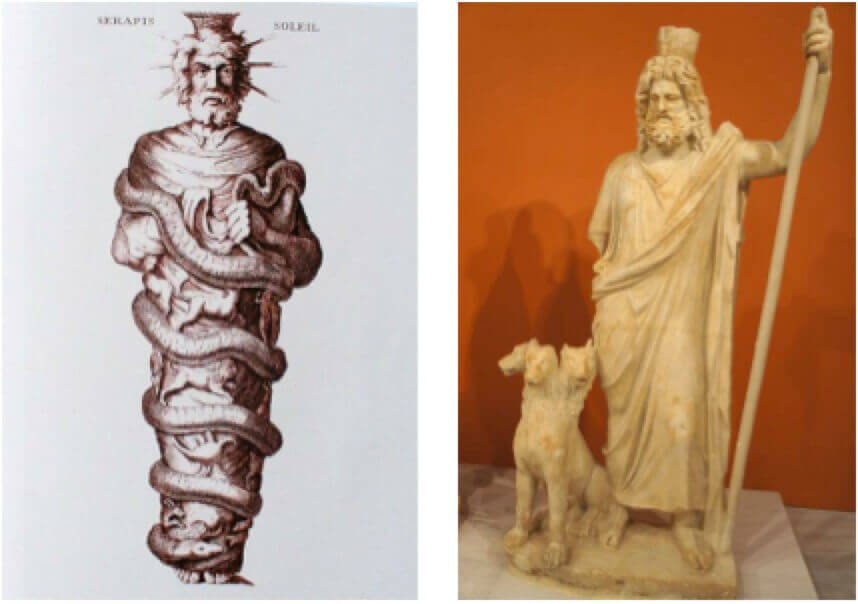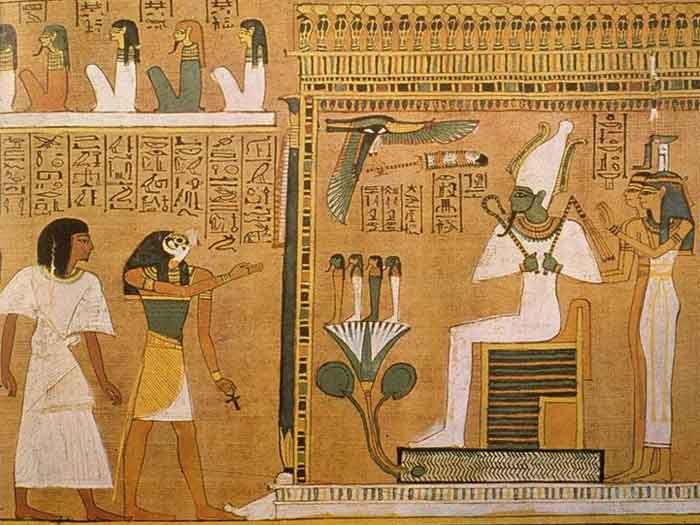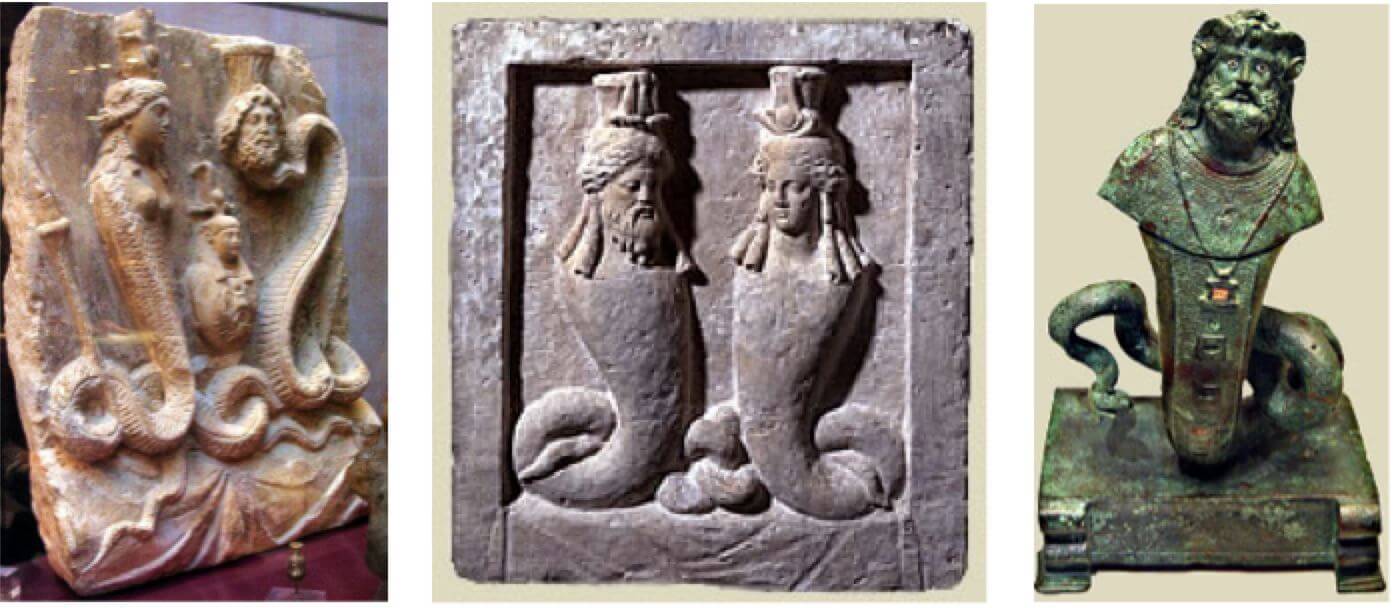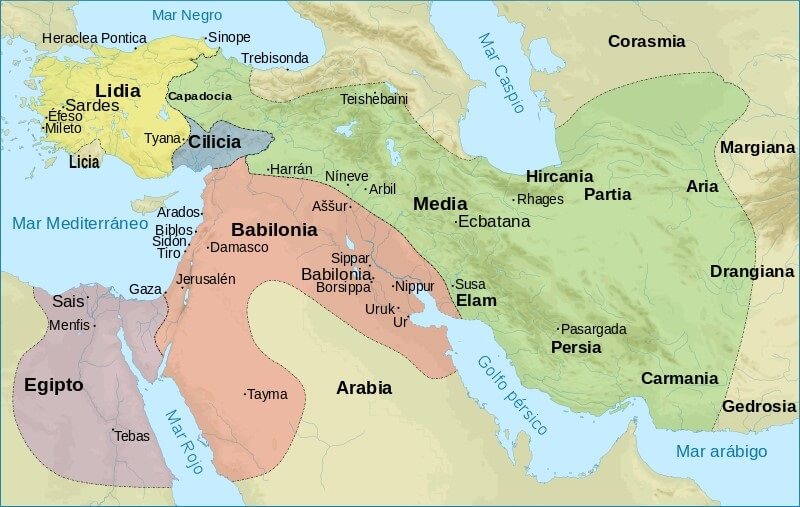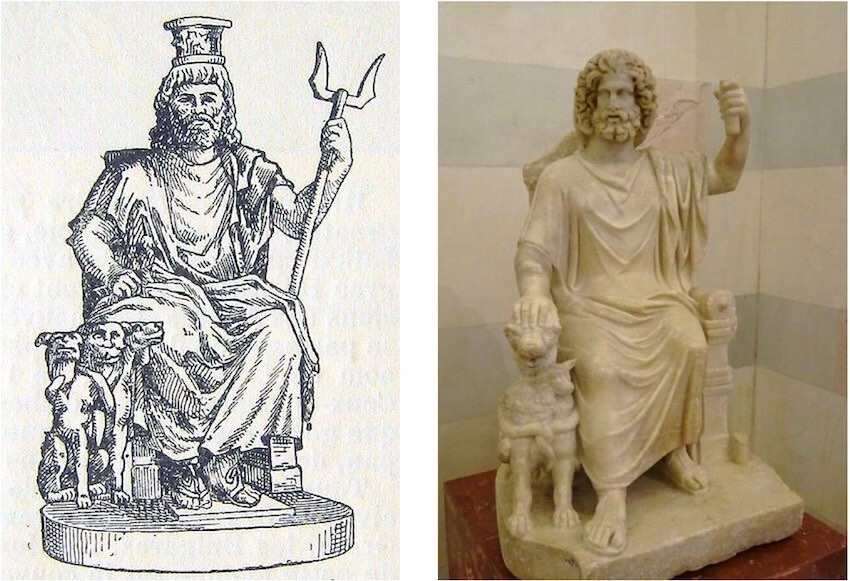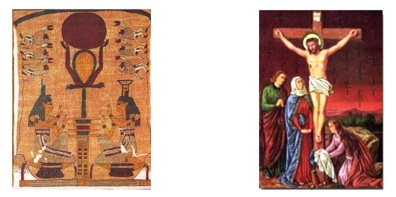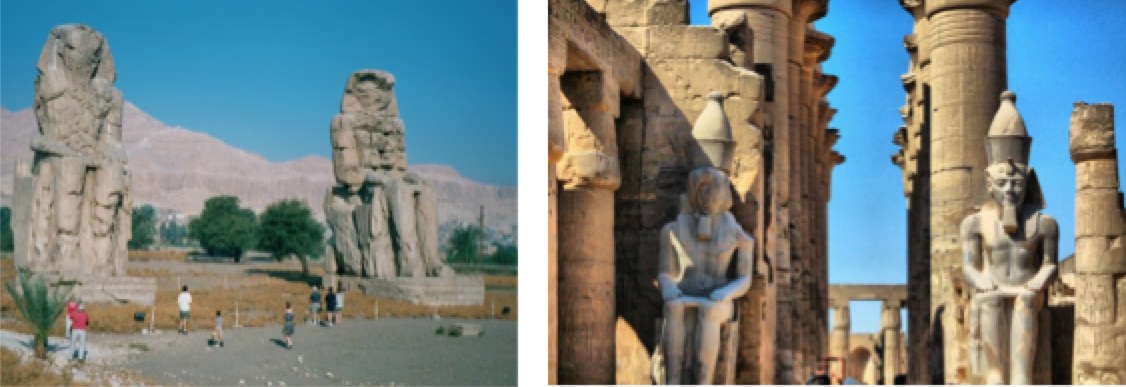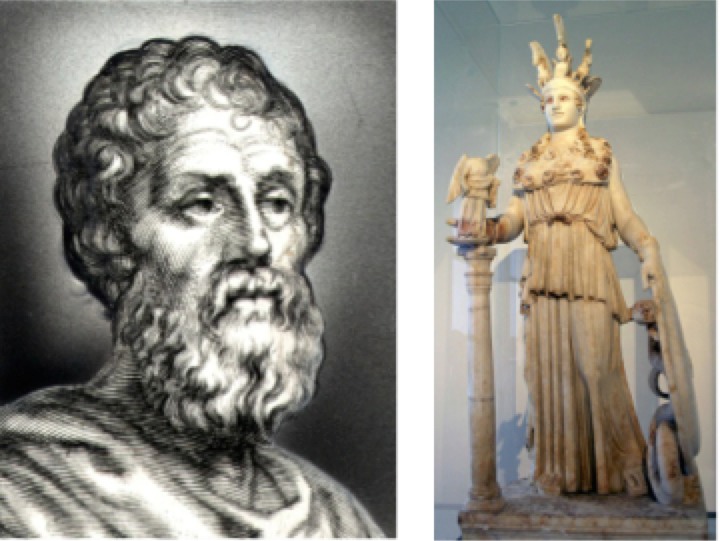|
|
Serapis BeyDear friends! We continue to talk about the Masters of Wisdom: their history, certain incarnations and the essence of the Teachings. All articles about the Masters are published in the section "Ascended Masters". In this issue, we begin with the first part of an article about Master Serapis Bey. Serapis is an unusual God. On numerous images he takes different forms: he is a serpent with a human head, then he is wrapped in a serpent, between the rings of which are visible symbols of the signs of the Zodiac. And often - it's a man in a Greek tunic with a basket on his head. Sometimes he is depicted with horns. What is the essence of such metamorphosis? Who is Serapis really?
Let us turn to a reliable source - Helena Petrovna Blavatsky's Theosophical Glossary: SERAPIS (Eg.) A great solar god who replaces Osiris in the popular worship, and in whose honour the seven vowels were sung. He was often made to appear in his representations as a serpent, a “Dragon of Wisdom”. The greatest God of Egypt during the first centuries of Christianity. ” Immediately there are questions. What is the connection between Osiris and Serapis? Why is Serapis represented as a serpent and what does this symbol represent? Why was Serapis the highest god of Egypt in the first centuries of Christianity, and not earlier or later? We will look for answers.
Who is Osiris? The connection between Osiris and SerapisOsiris, according to the modern encyclopedia, is the god of regeneration, the king of the afterlife in ancient Egyptian mythology and the judge of the souls of the deceased. In the "Theosophical Dictionary", there is a pretty large explanation considering various aspects of this God. H.P. Blavatsky notes the identity of Osiris with Ahura-Mazda (Sanat Kumara) as the First Cause, self-created god, Logos. And as far as its differentiation and personification (when immersed in more and more dense layers of creation), Osiris becomes different aspects, i.e. turns into other deities that have their names. “OSIRIS (Eg.). The greatest God of Egypt, the Son of Seb (Saturn), celestial fire, and of Neith, primordial matter and infinite space. This shows him as self-existent and self-created god, the first manifesting deity (our third Logos), identical with Ahura Mazda and other “First Causes”. For as Ahura Mazda is one with, or the synthesis of, Amshaspends, so Osiris, the collective unit, when differentiated and personified, becomes Typhon, his brother, Isis and Nephtus his sister, Horus his son and his other aspects.”
In “Isis Unveiled”, H.P. Blavatsky describes the sunny nature of Osiris:  Osiris-Apis in two of his guises “Neither Osiris nor Horus are ever mentioned without being connected with the sun. They are “The sons of the Sun.” “Isis Unveiled” also gives a quote from the book of Edward Pokok, a British orientalist and priest who lived in the XV century, who was advocating the identity of Egyptian, Greek and Indian mythology. Pocock describes the head of the Rajput solar race called, “The Great Sun” in the ancient Hindu tradition, and says that, “ “this Great Sun was deified at his death, and according to the Indian Doctrine of the metempsychosis, his soul was supported to have transmigrated into the bull ‘Apis’, the Sera-pis of the Greeks, and the SOORAPAS, or ‘Sun-Chief’ of the Egyptians…Osiris, properly Oosras, signifies both ‘a bull’, and ‘a ray of light.’ Soora-pas (Serapis) the sun chief,” for the Sun in Sanskrit is Surya.” (H.P. Blavatsky, Isis Unveiled, Volume 2, (Theosophy Trust, 2006), 403. Thus, the connection between Serapis and Osiris becomes clear. Osiris is the highest aspect of Serapis, and therefore the latter has the same solar nature. Osiris' soul after differentiation (allegorically - death), turns into the Apis bull, which has the nature of light, and thus turns it into Serapis. This is reminiscent of the “fall into generation” of the Sons of Fire, who spiritualized thereby the lowest physical forms of the Third human Race. (To learn more about this process, review the chapter entitled “The Fall of Angels” from the book "Good and Evil” by Tatyana Mickushina; an individual interpretation of The Secret Doctrine by Helena P. Blavatsky".) In the teachings of the Gnostics, the bull Apis symbolizes the lower physical nature of man. After death, the soul that has not yet been freed from the body is called Serapis, and the one that gained freedom is called Osiris. In ancient times, the worship of the sun was widespread. The sun was called "the engenderer of the gods who are the successors of the Sun." His life-giving rays were the symbol of "Him who is the Master of Life and Death." “It was the religion of the earliest Vedic Brahmans, who call, in the oldest hyms of the Rig-Veda, Surya (the Sun) and Agni (fire) “the ruler of the universe,” “the lord of men,” and the “wise king.” It was the worship of the Magians, the Zoroastrians, the Egyptians and Greeks, whether they call him Mithra, or Ahura mazda, or Osiris, or Zeus, keeping in honor of his next of kin, Vesta, the pure celestial fire.” (H.P. Blavatsky, Isis Unveiled, Volume 2, 403. However, in ancient times, people worshiped not only the Sun. H.P. Blavatsky speaks of two dynasties of kings and gods. “The earliest legends of the history of India mention two dynasties now lost in the night of time; the first was the dynasty of kings, of “the race of the sun”, who reigned in Ayodhia (now Oude); the second that of the “race of the moon”, who reigned Pruyag (Allahabad). […] Champollion’s Manifestation to the Light, reminds in every chapter of the two Dynasties of the Kings of the Sun and the Moon. Later, these kings became all deified and transformed after death into solar and lunar deities.” The worship of lunar deities, according to H.P. Blavatsky was the earliest distortion of the great original faith in the Solar Gods. And, as we will see later, it led to the persecution and destruction of the solar cult in the middle and subsequent centuries. Let us examine another quotation from the Theosophical Dictionary, explaining the presence of zodiac signs on the image of Serapis, as one of the aspects of Osiris. “As a solar deity he (Osiris) had twelve minor gods under him – the twelve signs of the Zodiac. Though his name is “Innafable”, his forty-two attributes bore each one of his names, and his seven dual aspects completed the forty-nine, or 7х7; the former symbolizes by the fourteen members of his body, or twice seven. ” Thus, Osiris has a whole Hierarchy of lower deities, (including the gods of the Zodiac), containing his spiritual quintessence. Being gradually densified, every aspect of Osiris acquires features characteristic of an increasingly dense plan of existence, up to the physical. “The four chief aspects of Osiris were – Osiris-Phtah (Light), the spiritual aspect; Osiris-Horus (Mind), the intellectual manasic aspect; Osiris-Lunus, the “Lunar” or psychic, astral aspect; Osiris-Typhon, Diamonic, or physical, material, therefore passional turbulent aspect. In these for aspects he symbolizes the dual Ego – the divine and the human, the cosmico-spiritual and the terrestrial." As H.P. Blavatsky points out, “this Egyptian conception is the most suggestive and the grandest, as it embraces the whole range of physical and metaphysical thought…Thus the god is blended in man, and the man is deified into a god.” (H.P. Blavatsky, The Theosophical Glossary (London: The Theosophical Publishing Sosciety, 1892), 243. http://blavatskyarchives.com/theosophypdfs/blavatsky_the_theosophical_glossary_1892.pdf ) This deep meaning of the ancient beliefs, which embodies the goal of the evolution of the universe and man, was gradually lost and turned into the exact opposite: the Solar Gods were identified with Evil, declared pagan idols and demons and replaced by new gods.
Serpent symbolLet's see how Serapis was portrayed in the first centuries before the new era, and the first centuries of the new era. 1. Isis-Termutis, Serapis-Agathodaemon and Osiris Canopus. Stele of the Greco-Roman period, Leiden Museum.
The symbol of the Serpent is ancient and dates back to the creation of the Earth as a physical plane planet, associating with the "Spirit of God", whose breath "sat out" cosmic matter - by analogy, like the way snakes lay eggs. “Isis Unveiled” (vol. 2) informs about the interpretation of the initial Serpent cult by Initiates. “In Vol. 1, we quote from the Serpent Mantra, in the “Aytareya-Brahmana”, a passage which speaks of the earth as the Sarpa Rajni, the Queen of the Serpents, and “the mother of all that moves.” These expressions refer to the fact that before had become egg-shaped or round it was a long trail of cosmic dust or firemist, moving and writhing like a serpent. This, say the explanations, was the Spirit of God mpving on the chaos until its breath had incubated cosmic matter and made it assume the annular shape of a serpent with its tail in its mouth – emblem of eternity in its spiritual and of our world in its physical sense.” The symbolism of the Serpent was used in various aspects of evolutionary processes, both for the planet and for mankind.  Image of the early Christian era. “According to the notions of the oldest philosophers…the earth, serpent-like, casts off its skin and appears after every minor pralaya (periods of quiescency) in a rejuvenated state, and after the great pralaya resurrects or evolves again from its subjective into objective existence. Like the serpent, it not only “puts off its old age,” says Sanchoniathon, “but increases in size and strength.” This is why not only Serapis, and later Jesus, were represented by a great serpent. ” (H.P. Blavatsky, Isis Unveiled, Volume 2, 449. http://realitychange.net/wp-content/uploads/2017/07/Isis_Unveiled_Vol_2_V2.0.pdf ) In the process of the evolution of humanity, Nagis, the ancient Serpents, whom the Secret Doctrine calls the “Sons of Will and Yoga”, took part. Nagis were generated at the beginning of the Third Race. In ancient Indian legends about several Rishis and their progeny, it is said that “Pulastya (deity created by Brahma himself) is represented as a father of all Serpents and Nagas, who were of oviparous generation.” "In the Secret Doctrine, the first Nagas – Beings wiser than the Snakes - are the Sons of “Will and Yoga”, born to complete separation of the sexes, "developed in eggs, embodying human germs created by the power (Kriyashakti - Thought) of the Holy Wise Men, "belonged to the early Third Race." Thus, the Serpent personified the divine Wisdom. That is why many deities were depicted as Serpents, as well as with serpents and dragons, as attributes of this Wisdom. Subsequently, the Serpent became not only a symbol of the gods, but also a symbol of the Adept. “The Serpent and the Dragon were the names given to Sages, Initiated Adepts of ancient times” (H.P. Blavatsky, The Secret Doctrine, (London: The Theosophical publishing Company,1888), V. 1) Only in later centuries did the image of the Serpent became associated with Evil.
The cult of Serapis The name of Serapis in Egyptian hieroglyphs. The last hieroglyph means "god, king There are different versions of the origin of the cult of the god Serapis. The most common point to the 4th century BC. as at the earliest date mentioned in found historical sources. 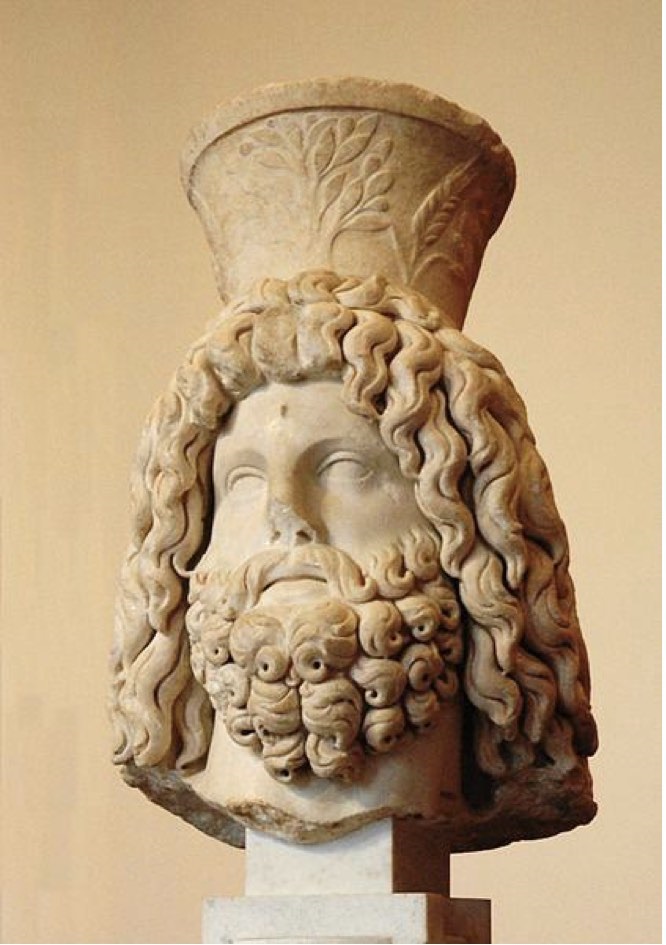 Bust of Serapis. Marble. third century AD. Found in Carthage, Tunisia Found in Carthage Thus, the writings of the ancient Greek historian Arrian’s "Anabasis Alexander" and the ancient Greek writer and philosopher Plutarch’s "The Life of Alexander" state, that Serapis not only had a temple in Babylon, but he was the only god mentioned in connection with the death of Alexander the Great in 323 BC. in Babylon. This gives grounds for some historians to believe that the cult of Serapis originated in Babylonia. E.P. Blavatsky in Isis Unveiled (vol. 2) states the following: “At that time Grecian, Asiatic and Egyptian ideas had undergone a remarkable transformations. The Mysteries of Dionysus-Sabazius had been replaced by the rites of Mithras, whose “caves” superseded the crypts of the former god, from Babylon to Britain. Serapis, or Sri-Apa, from Pontus, had usurped the place of Osiris. The king of Eastern Hindustan, Asoka, had embraced the religion of Siddhartha, and sent missionaries clear to Greece, Asia, Syria, and Egypt, to promulgate the evangel of wisdom…The legends of Gautama superseded the myths of Horus, Anubis, Adonis, Atis, and Bacchus.” From this fragment, we learn that we are talking about third-fourth centuries BC, since King Ashoka lived in 304 - 232 years, BC. The cult of Serapis existed at that time in Ponte, which was the ancient name of the terrain of northeastern part of the Asia Minor, which in the north adjoined the Eleusinian Pontus (Black Sea). Significant changes took place in the religious life of nations.
Perhaps these transformations were also associated, with the crusades of Alexander the Great, as a result of which large masses of people moved or relocated. Thus, in Egypt at the end of the 4th century BC, many Greeks and Macedonians appeared, and the introduction of the cult of Serapis could become a way of uniting them both among themselves and with the local population, i.e. a way of combining the Egyptian and Greek religious traditions. At the same time, as the Encyclopedia of Ancient Egypt states, "in its "origin" this deity should have been associated with the gods of the Egyptian pantheon, since in antiquity only the god who had local origin could have holy authority over a certain territory. That is why the roots of the Serapis cult go to the cult of the Memphis Osiris-Apis.” The formation of the name Serapis is interpreted as: Osiris + Apis = Osiris-Apis / Oserapis / Serapis or Sarapis (different pronunciation depending on the dialects). 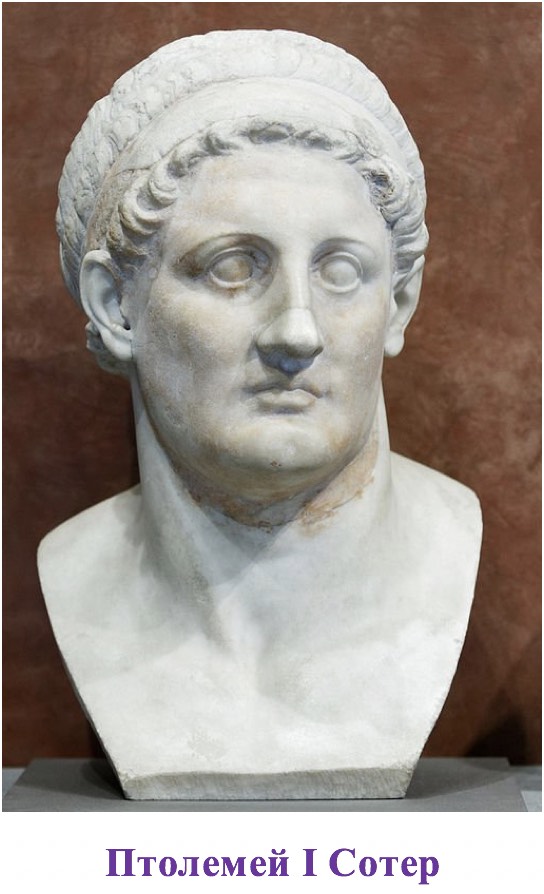 Ptolemy I Soter The most common version of the origin of the cult of Serapis is that under Ptolemy I Soter there was an attempt to create an image of a syncretic (connecting different creeds) deity – Serapis. From his youth, Ptolemy was a friend of Alexander the Great, then a military commander in his army, and after Alexander's death he became the king of Egypt (he reigned in 323-283 / 282 BC). He is the founder of the Ptolemaic dynasty. According to the description of Plutarch, King Ptolemy had a dream in which an unknown god (Serapis) instructed the king to steal a sacred statue from the city of Sinop and transport it to Alexandria, which was done with the blessing of the Delphic Oracle. The priests recognized god Serapis in the statue. According to the encyclopedia of ancient Egypt, the first Ptolemies not only introduced Serapis to the host of Egyptian deities, but made him the supreme god, a patron of the new royal dynasty and new capital of the country - Alexandria. The city was founded by Alexander the Great in the Nile river delta and up to the fourth-fifth centuries AD, Alexandria was one of the most important centers of the Hellenistic world. A temple Serapeum was dedicated to Serapis. This magnificent temple was in Alexandria, more precisely, in Canopa, a city located not far from the capital. This temple, built by Ptolemy III (who reigned from 246 to 222 BC), was the main religious center of for the deity and was famous for its amazing healing power. The second center of worship was Memphis. According to the descriptions, the Alexandrian Serapeum was the largest of the temples dedicated to Serapis. In addition to the images of God, it housed a branch of the Alexandrian Library. This is how the Roman historian Ammianus Marcellinus described the temple: “In the city [of Alexandria] there are very high temples. Serapey stands out among them. My speech is powerless to describe it. Extensive courtyards surrounded by colonnades, breathing life statues, and many other works of art decorate it so much that after the Capitol, which glorious Rome immortalizes itself, the Universe does not know anything more magnificent. In this temple the treasures of the book of invaluable dignity were placed. " The statue of Serapis, created by the sculptor Briaxis for Alexandria's Serapeum, was a male figure with a beard, like Zeus, in a chiton, sitting on a throne in a headdress – modius (a bread measure) or, according to another version, in kalaf - a symbol of fertility and abundance. Calaf was decorated with the image of grain ears and branches of olives. There was the scepter in the left hand of the statue of Serapis, the right hand of god was rested on the head of the terrifying dog Kerber (Cerberus), which indicates the underground symbolism of the deity.
Serapis was often depicted as a Greek god, but with an Egyptian paraphernalia, combining the iconography of many cults, symbolizing abundance and resurrection. Serapis united in himself many gods. Like Osiris, he was considered the patron saint of fertility and the land of the dead. The Greeks identified Serapis with Poseidon, the master of the water element, so his images were placed in the bow of the ships. As the god of the Sun, Serapis was identified as Apollo, Helios, as the Lord of the gods – Zeus himself, as Asclepius - the healer, as Dionysus - the god of fertility, and other gods. It is noted In the Secret Doctrine (vol. 2): “Esculapius, Serapis, Pluto, Esmun and Kneph, are all deities with the attributes of the serpent… They are all healers, givers of health, spiritual and physical, and of enlightenment.” In the Roman period, Serapis began to be revered as a healer, who was able to solve questions of life and death. People came to him for predictions, as if he was an oracle, asking him for deliverance from unhappiness and for advance in rank. This led to the fact that Serapis began to be perceived not only as the supreme, but as the highest transcendent deity, to which it was possible to appeal with any request. In the first to third centuries BC, during the reign of the Ptolemies, this cult of Serapis was widely spread in Asia Minor, Greece and the Northern Black Sea region. More than a thousand statues, temples and monuments were erected in honor of Serapis. The temples of Serapis appeared in many places outside of Egypt, where the Greek-speaking population lived. In Greece, the sanctuaries of Serapis were opened in the holy city of Apollo, in Delphi, in Corinth and in one of the cities of Boeotia (a region in Central Greece), Also, the worship of Serapis was introduced in Athens. Small and large mysteries were held in the shrines. The Little Mysteries were dedicated to Isis and intended for the laity; the great mysteries were dedicated to Serapis and Osiris, and only priests who had passed the ordeals during the dedication in the temple of Serapis could participate in them.
In the Roman period, Serapis’ popularity continued to grow, and he often served as the husband of Isis in temples outside of Egypt. Thus in Rome, deities were worshiped in the Temple of Isis and Serapis, which was built on the Campus Martius. Numerous finds testify to the prevalence of the cult. Images of Serapis are found in abundance on the coins of the Hellenistic time and his figurines were an indispensable accessory for residential buildings. They were fastened in doors, windows and on walls as charms. Three-dimensional images of Serapis were found on medallions, lamps, altars.
For seven hundred years, that is, for 28 generations (!), Serapis was the supreme deity of Egypt and Greece. However, at the end of the fourth century AD, a real crusade against the “pagans” began, resulting in the followers of all mystical religions being placed in this category
How Christian fathers turned Serapis Bey into a devilThe decline of the cult of Serapis began with the de-struction of the main shrine, the temple in Alexandria and the magnificent statue of God housed within it. This was done by the order of the Roman emperor Theodosi-us I, who was a determined and ruthless ruler. According to Wikipedia, Theodosius “broke with the religious system established by the emperor Constantine, which generally maintained the neutrality of the state in relation to the various cults and confessions of the citizens of the empire. Under Theodosius, the dogmas of Christi-anity began to be recorded not as a result of free discus-sion in church circles, but were approved by government decrees. ” Theodosius approved the Nicene formula of Christianity as a single state religion, began to persecute other religious movements in Christianity as heretical, and banned pagan cults, for which he was awarded the epithet “The Great” by the Christian writers. Roman soldiers broke into the temple of Serapis in Alex-andria, destroyed the statue, burned the temple library, and demolished the building. Socrates, the historian of the church, later told that the axes were broken by strik-ing the statue, and at the base of the destroyed temple the soldiers saw the monogram of Christ. It is appropriate here to refer again to the Theosophical Glossary of H.P. Blavatsky, where the article on Osiris speaks about the connection between the Egyptian and Christian gods. The article contains the Phoenician inscription, where Osiris is called Eloh. But at the same time, Eloh (Eloah, Elohim) is the title of Jehovah, the God of the Jews (the term is mentioned throughout the Hebrew Scriptures, beginning with Gen. 1: 1). H.P. Blavatsky quotes the author, who reflects on the similarities of Osiris and Je-hovah: “…the question is sure to be asked, and ought to be humbly answered – What was the meaning meant to be conveyed by the two phrases respectively, Osiris-Eloh and Jehovah-Eloh? For my part I can imagione but one answer, viz., that Osiris was the national God of Egypt, Jehovah of Israel, and that Eloh is equiva-lent to Deus, Gott or Dieu (god, deity)”. Osiris and Jehovah are Elohims and Logoses — mani-fested deities in every nation, an external expression or consequence of an eternally hidden Reason. The only thing is Jehovah's nature is not sunny, but lunar, as men-tioned in the Secret Doctrine (Vol. 2): “... in truth, Jehovah is but a “ lunar ”and “genera-tion” God. And later in the article about Osiris, it is about the simi-larity of the legends about Osiris and Christ: “As to his human development, he is (Osiris), as the author of the Egyptian Belief has it … “One of the Savious or Deliverers of Humanity …As such he is born in the world. He came as benefactor, to relieve man of trouble … In his efforts to do good he encoun-ters evil…and he is temporarily overcome. He is killed…Osiris is buried. His tomb was the object of piligrimage for thousands of years. But he did not rest in his grave. At the end of three days, of forty, he rose again and ascended to Heaven. This is the story bof his Humanity” (Egypt. Belief) […] It also proves that the legend of Christ was found ready in almost all its details thousands of years be-fore Christian era, and that the Church fathers had no greater difficulty than to simply apply it to a new personage”, - states H.P. Blavatsky. In general, the biblical texts have many parallels with the ancient Egyptian letters, ranging from divine beings, telling the mothers of Osiris and Jesus about the immi-nent birth of their future savior and ending with the res-urrection of both after death.
However, the servants of the Christian church in the 4th century AD did not allow a single thought about the existence of the connection between Serapis (Osiris in his highest aspect) and Jehovah, or the connection be-tween Osiris-Serapis and Christ. For them Serapis and other pre-Christian gods were merely pagan idols. And everything alien, in their opinion, must be declared as evil and should be destroyed. The Roman Catholic Church did a fine job with this, declaring the worship of the pagan gods a deal with the devil. Here is how Isis Unveiled (vol. 2) tells about this most difficult period of history: “We ought, perhaps, make a brief notice of the Eu-ropean Devil. He is genius who deals in sorcery, witchcraft, and other mischief. The Fathers taking the idea from the Jewish Pharisees, made devils of Pagan gods, Mithras, Serapis, and the others. The Roman Catholic Church followed by denouncingthe former worship as commerce with the powers of darkness. The malefecii and witches of the middle ages were thus but the votaries of the proscribed worship. Magic in all ancient times had been considered as di-vine science, wisdom, and the knowledge of God. The healing art in the temples of Esculapius, and at shrines of Egypt and the East, had always been magi-cal. […] All was now changed. Ignorance was ethroned as the mother of devotion. Learning was denounced, and the savants prosecuted the sciences in peril of their lives. They were compelled to employ a jargon to conceal their ideas from all but their own adepts, and to accept opprobrium, calumny and pov-erty. ” Moon gods triumphed! Over the next centuries, so many "sorcerers", adherents of the forbidden cult, were burned on the fires of the Inquisition, that the worship of Serapis was completely destroyed in the territories of the Christian world. The name of the deity remained only in historical documents, on sculptures and other works of art. But, having disappeared as a personified deity who was worshiped by the nations, Serapis did not disappear as the Great Teacher.
A look into the past. Some earthly incarna-tions of SerapisBefore becoming a deity for the Hellenistic world for 700 years, Lord Serapis had many other incarnations. This information can be found in the book by Mark and Elizabeth Clare Prophet, "The Masters and Their Re-treats" (this chapter was created on the basis of this book). It states that Serapis came with Venus along with the Old Days, also known as Sanat Kumara, to rekindle the sacred fire in the hearts of lost humanity. Serapis was a priest in the Temple of Ascension in At-lantis, where he was the keeper of the flame of ascen-sion, and before the flooding of Atlantis, he transferred this flame to Luxor in Egypt. In Luxor, Serapis and his brothers, erected a new Temple of the Ascension, and from that time they were reincar-nating in Egypt specifically to maintain this flame in the Temple. During these lives, he led the construction of the greatest architectural structures, including the architecture of the Great Pyramid, created more than 2500 years BC. Serapis Bey postponed his ascension until about 400 BC. 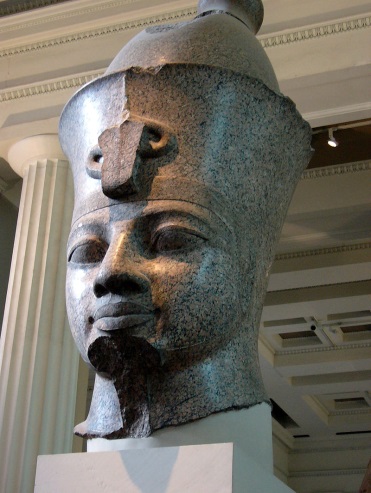 Serapis was embodied by the Egyptian pharaoh Amenhotep III(reigned in 1388 - 1351 BC), the son of Thutmose IV and the grandson of Thutmose III (the embodiment of Kuthumi). His son and heir to the throne was Amenhotep IV, known as Akhenaten. The reign of Amenhotep III is considered as one of the greatest periods of prosperity of the ancient Egyptian civilization. Pharaoh maintained peaceful diplomatic relations with all countries for most of his reign. Part of the innumerable treasures of his treasury was spent on the construction of magnificent temples and palaces. Pharaoh expanded the Temple of Karnak on the banks of the Nile and built a funerary temple, the remains of which are known today as the Colossi - sitting statues carved from solid stone, found on the banks of the Nile. The greatest creation of Pharaoh was the temple of Lux-or, fragments of which are still well-preserved in our time. This temple in its geometry and design was a text-book of advanced science, art and philosophy. Current-ly, the temple of Luxor is the physical continuation of the etheric abode - the Temple of the Ascension.
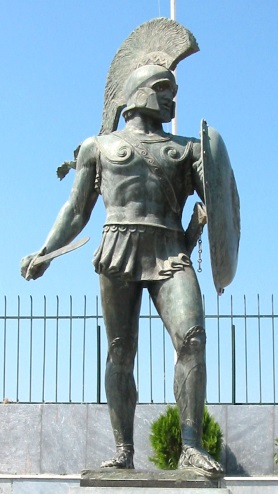 Serapis was also incarnated as the King of Sparta Leo-nid (reigned 491–480 BC). He commanded the Greeks, who heroically resisted the invasion of the countless Per-sian army in the mountain pass at Thermopylae, which was the gateway to central Greece. For two days, Leonid restrained the Persian army, much superior to the Greeks, which was led by King Xerxes. On the third day, Leonid and the three hundred Spar-tans who made up his personal guard fought to the last man. Their heroic resistance allowed the Greek fleet to retreat and later crush the Persians. Leonid's example helped shape the national traits of the Greek people. Historians call this battle an example of the highest courage and fearlessness shown in the battle for a just cause against the multiple time superior enemy forces. According to the Prophets, three hundred Spartans were the three hundred chelas of Luxor, who were incarnated with Serapis. These were people of exceptional courage. Some of them are the Ascended Masters today, others remain in embodiment. Serapis Bey was embodied as the sculptor Phidias, who lived in the 5th century BC. in Athens, and was consid-ered the greatest of all Greek sculptors. His fame was enormous. He was the architect of the Parthenon, and supervised the extremely complex work on its construction. In the Parthenon, he installed a 12-meter statue of Pallas Athe-na, made of gold and ivory.
Phidias also created a huge statue of Zeus from gold and ivory, which stood in the temple of the ancient Greek city of Olympia. The creations of Phidias, characterized by sublime beauty and spirituality, had a strong influ-ence on the subsequent development of Western art. In the Hellenistic period, after its ascension, Serapis be-came one of the most significant gods of the Egyptian and Greco-Roman pantheons, as already mentioned above.
Serapis Bey - Master of Wisdom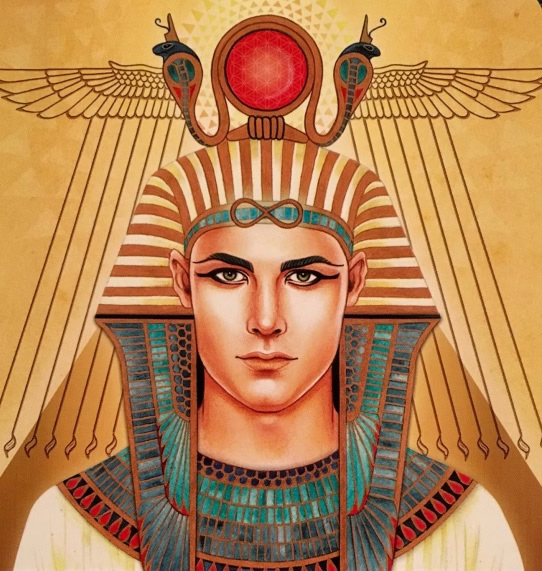 In the ascended state, Serapis Bey (Bey – is a Turkic title and rank, which original means leader) continued and continues to help humanity, like other Masters, who many millions of years ago, endowing us with the “spark” of Christ Self, a divine particle of Fire - part of ourselves. (The process of “the fall of angels into generation” is described in detail in the book by Tatyana N. Mickushina “Good and Evil. An individual interpretation of The Secret Doctrine by Helena P. Blavatsky”). In the letters and diary entries of H.I. Roerich 1933-1936, it is mentioned that Serapis is the previous Lord of Shambhala (see letter of 11/18/35, diary of 10/29/33, 12/13/36). It is known that, together with the Masters El Morya and Kuhumi, Serapis Bey played a huge role in the creation of the Theosophical Society in the 19th century. According to the Prophets, among the first letters that the adepts and Masters sent to the founders of the Theosophical Society were the letters of Serapis Bey and the Brotherhood in Luxor. Serapis led the training as a chela for Helena Blavatsky and Colonel Henry Olcott, who co-founded the Theosophical Society and became its president. In the six-month period preceding the founding of the Society in 1875, Serapis sent to Col. Olcott many inspirational letters with instructions. For the most part, these letters were written in gold ink on thick green parchment, contained Serapis's own signature and the esoteric symbol of the Brotherhood in Luxor. Many of the letters a characteristic call from Serapis to the reader: “Try”. Master Serapis emphasized the need to have courage and fearlessness - the same volitional qualities that he showed himself when he was the King Leonid. In the twentieth century, through the Messenger of the Great White Brotherhood, Mark Prophet, Serapis Bey transmitted the book “Dossier on the Ascension: The Story of the Soul's Acceleration Into Higher Consciousness on the Path of Initiation.” This is a real tutorial on overcoming those weaknesses that obstruct the ascent. It gives instructions on accelerating the path. In another book by Elizabeth Clare and Mark L. Prophet called “The Masters and their Retreats”, Serapis tells us that we ascend daily if we make daily efforts. “Our thoughts, our feelings, our daily deeds are all weighed in the balance. We do not ascend all at once, but by increments as we pass our tests and win our individual victories.” In the 21st century, Serapis Bey, along with other Ascended Teachers, continued his work through the Messenger of the Great White Brotherhood, Tatyana Nicholaevna Mickushina. In 2005-2010, Serapis Bey transmitted through Tatyana N. Mickushina 12 messages, the first of which was given on March 29, 2005, and the last one on December 29, 2010. In the dictations, the Teacher addresses those who once visited his Retreat, his Temple in Luxor, and calls upon them to recall the knowledge that they had gained in this Temple. And since the time has changed, the learning and initiations of modern chelas are now taking place in ordinary life – as the Masters use the circumstances of our life so that our souls receive everything they need for training. "... the circumstances of your lives make you overcome within yourselves what is preventing you from acquiring the qualities of humility and obedience. " (Further quotes are given from the books "Words of Wisdom"). In addition, we gain knowledge during the period of a night's sleep, unconsciously or quite consciously visiting the etheric Retreats of the Masters. And in order to make the learning process in a dream as effective as possible, Serapis Bey suggests the following before going to bed: “ Before falling asleep, visualize a picture of my retreat and try to formulate your questions and the things that cause your doubts.” “ Your last thought before sinking into sleep and before your consciousness leaves you must be a desire to visit our sacred retreats and to bring the knowledge granted to you in them to your external consciousness during the following day.” 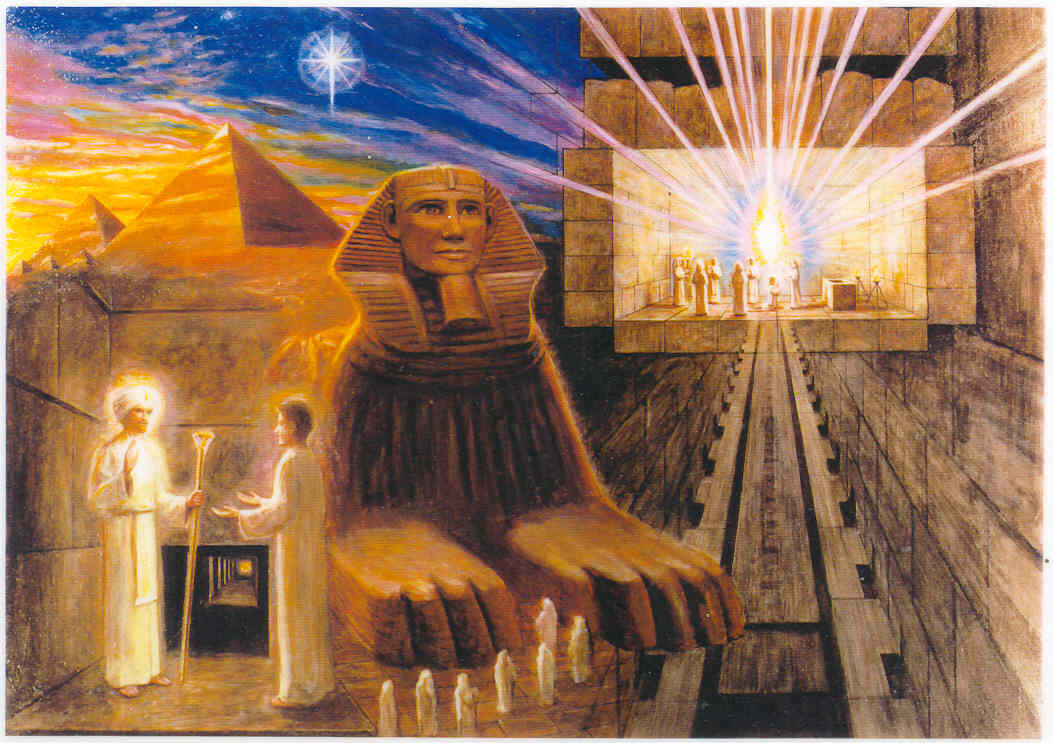 In His Message “My instruction to the disciples,” dated as December 26, 2007, Beloved Serapis Bey tells about himself and his task in helping mankind: “I serve on the Fourth Ray as Hierarch of this Ray. You probably know that I give my daily classes to my disciples in my retreat above Luxor. You do not need to go to Egypt to establish a connection with me. You just need to constantly keep my image before your mind's eye and think about me, especially before bedtime. This is enough for you to be invited to my retreat and for our introductory conversation to take place. <...> I am the Master who prepares you for the Path of Initiations. <...> No matter how you try to slip away from the Path and whatever strong arguments your carnal mind comes up with, sooner or later all of you will come to me for a talk because I decide how you will proceed further. I see the level of readiness of each of you and determine the better way for you to pass your particular test in the existing circumstances of life.” And since Serapis Bey is a strict Teacher, which he reports in his Messages, he demands extraordinary discipline from his students, at the same time helping them in mastering the discipline. “ …because if a disciple does not obey the Teacher whom he himself has chosen, he is deprived of the right to be taught under our guidance.” (March 29, 2005) Discipline, above all, is the constancy of the effort: “by daily work on yourselves, by daily choices and initiations.” "Day after day, year after year." (July 14, 2006).
The Essence of the Teaching at the Present Stage In the Messages of the 21st century, given through Tatyana N. Mickushina, Teacher Serapis Bey, says that a new stage in the evolution of humanity has now come: the stage of abandoning illusion and returning to the real world of God. Once long ago the Lords of Wisdom gave us a guide who would help humanity to return Home, and the main goal for us is to establish a connection with this guide. “...you are given a guide, your Guardian Angel, your Sacred Christ Self. This guide must set you on the right Path, the Path of your returning to your Father’s Kingdom. All of our external Teaching that we are giving through this or any other Messenger is aimed at restoration of the link with that part of yourself that remembers who you are. The tighter your link with your real part, the faster your returning Home will be. ” (March 29, 2005) All the trials and initiations that we go through in life are aimed precisely at overcoming the resistance of our ego, our illusory part, and to establish contact with our immortal part. However, Serapis Bey claims that we studied this Truth in ancient Lemuria and Atlantis and in all the Mystery Schools of the past and present that ever existed on Earth. And we only need to remember our Origins and return to them, following the Divine Plan. The basis of the Teaching of Serapis Bey is based on several important instructions, which without clarifying would be impossible to advance towards the goal. 1. Admit responsibility for all the circumstances of our lives.“The first commandment I am giving you is that you must realize that nobody is guilty of the condition and position on the path that you have at present. Only you yourselves are responsible for all the circumstances of your lives. As soon as you realize that provision of my Teaching, you will become open to perceive many Truths that had been blocked by your consciousness before. ” (July 14, 2006) With our choices, big and small, we add up the reasons for what happens to us in the future. And therefore we have no one to blame for our sufferings, except ourselves. From the first statement follows the second, which is more difficult to perform. 2. Accept with humility absolutely all the events taking place in our lives.“...the main condition for passing the test is to accept everything that happens to you in the outer world with humility. Can you hear me? Accept absolutely everything. Nothing can happen to you that you have not created yourself. You are creating all the circumstances of your life by your choices that you make and by your reaction to everything that surrounds you in your life. For many people it takes many hundreds and thousands of embodiments to comprehend this very simple Truth. Somehow, in a mysterious way, when you encounter some difficulty in your life, the first thing you do is to look for the guilty ones around you. Believe me; ninety-nine percent of the difficulties that you face in your life are caused by your own actions in the past. And in one percent of the cases, your life difficulties are a test that can be given by me or by any of the Masters who are guiding your spiritual development. You continue studying in our schools and continue taking the exams until you master this first Truth, which is most difficult for you to master. ” (December 26, 2007) And as soon as this Truth is assimilated by us and we learn to respond correctly to everything that happens to us, this is a sign of our readiness for the Masters “to become our disciples, and in your external consciousness you start realizing our inner connection at the Higher plane. My more advanced disciples are able to connect with me instantly with the help of thought and receive the answer in their hearts to all or almost all questions they ask… This is the way our work goes, the work of the Brotherhood with humankind of Earth.” (December 26, 2007) 3. Venerate the Hierarchy.“The veneration of the Hierarchy, of the Masters, is a very important quality on the Path. That is because without veneration to the Master you will not be able to advance on the Path.” "We are offering you a tested Path that is based on the Guru-chela relationships and on the Path of Initiations when you receive all our help and support by voluntarily entering the steps of the Hierarchy." (July 14, 2006) This is the Path that has been tested over the centuries, by which all the great initiates of the past have led us. 4. Ask the Masters for help.“I will render you all the assistance that can be rendered to you, but do ask for the help. If in your pride you cannot even ask for our help, we cannot help you. Do not hesitate to remove everything from your consciousness that may prevent you from asking for our help and support. You know that the Law of this Universe has granted you free will, and we cannot violate your free will and render assistance to you without your request and without your call. But as soon as the call is uttered, we must respond. We will give you all possible help and support.” (December 22, 2006) 5. Cultivate in oneself Devotion, Love, Gratitude.“...one more important instruction... cultivate devotion and Love within yourself. Do not hesitate to thank us in the moments when you experience unconditional good spirits and are ready to love and hug the whole world. Send your Love to us.” (December 22, 2006) And this is the Law of energy exchange in the Universe: we are given to - and we must give. 6. To do concrete things, to bring new consciousness and new thinking to the world.“We are calling you not only to prayer but also to be ready to do practical deeds in the physical plane. It does not mean that you must leave everything and aspire to the place we show you. You must bring the Divine consciousness and Divine patterns to the place on the globe where you live, to your family, and to your workplace. You and only you are able to bring the new consciousness into the world. And I foresee that it will not be easy for you to do. You will be required to perform a feat, many feats, because everything surrounding you will resist. You will face one difficulty after another, one obstacle after another. It is very difficult to act in the world surrounding you, and it is very difficult to introduce the new consciousness and the new thinking into the world.” (June 24, 2007) “You are to stand up for the Divine behavioral patterns without being involved in a struggle. You are to stand up for the Divine Law. And you will have to demonstrate this Law in your lives. In the past many people were standing up for the new patterns and the new way of living so firmly that they slipped into intolerance and religious extremism. I warn you that you will rather sacrifice your life than allow any manifestation of intolerance or fanaticism. You are required to repeat the feat of Christ when He chose to go through His crucifixion instead of standing up for the Law with a weapon in His arms.” (June 24, 2007) The Master Serapis Bey calls us warriors and at the same time he says that we do not need to be involved in external struggle. The whole struggle, in which we must win, is exclusively an internal struggle, a victory over ourselves. And this is truly a feat that requires constant discipline, consisting in achieving and maintaining the highest possible level of consciousness. “You are warriors, but your task is not to battle constantly in the physical plane. Your task is to learn how to triumph in the Higher plane — in the plane of your emotions and thoughts. At the exact moment when you achieve a victory over your thoughts, feelings, and the negative states you experience, you will win on the physical plane of being because your achievements in the Higher planes will inevitably transform the physical plane. You do not need to look for rows of warriors that you have to join, because in the Higher plane you are a mighty army of Light. You are invincible and invulnerable as long as you keep your consciousness at the Divine level. All that is required from you now is to clothe yourselves in the real Divine consciousness and not to give up the level of your consciousness throughout the day and from day to day.” (June 23, 2009) Lord Serapis Bey reminds us that time has accelerated, and we can unleash many karmic knots for this incarnation, even the “karma of millennia”. “Therefore, it is not worth wasting your time. Start by developing new principles in your relationships with other people around you. Demonstrate firmness and courage, and refuse the temptations that you are seduced with in the deserts of your cities and towns.” (December 31, 2008) And in order to make it easier for us to make divine choices, the Teacher gives us images: “This image of aspiration for the Sun of the Divine Consciousness should be constantly kept in your mind's eye.” (December 31, 2008) “…a mountain climber clambering up a steep peak. Imagine that this peak is the Peak of the Divine Consciousness. The mountain climber pulls the whole planet on a rope after him.” (March 29, 2005) Instead of a conclusion, let us quote the words of Beloved Serapis Bey, given in the Message of December 31, 2008: “The only thing that can save the existing civilization from destruction is for as many individuals as possible to ascend to a new level of consciousness. Ten righteous men are capable of saving a city. A thousand righteous men are capable of saving the world.”
Elena Ilyina
Bibliography
All the Messages of Beloved Serapis Bey given through the Messenger
|
||||
|
|
